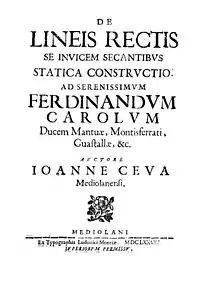Giovanni Ceva
Giovanni Ceva (September 1, 1647 – May 13, 1734) was an Italian mathematician widely known for proving Ceva's theorem in elementary geometry. His brother, Tommaso Ceva, was also a well-known poet and mathematician.
Giovanni Ceva | |
|---|---|
| Born | 1 September 1647 |
| Died | 13 May 1734 (aged 86) Mantua, Duchy of Milan |
| Nationality | Italian |
| Citizenship | Duchy of Milan |
| Alma mater |
|
| Known for | Ceva's theorem in elementary geometry |
| Scientific career | |
| Fields | Geometry |
| Institutions |
|
Life
Ceva received his education at a Jesuit college in Milan. Later in his life, he studied at the University of Pisa, where he subsequently became a professor. In 1686, however, he was designated as the Professor of Mathematics at the University of Mantua and worked there for the rest of his life.
Work

Ceva studied geometry for most of his long life. In 1678, he published a now famous theorem on synthetic geometry in a triangle called Ceva's Theorem. The theorem, already known to Yusuf Al-Mu'taman ibn Hűd in 11th century, states that if three line segments are drawn from the vertices of a triangle to the opposite sides, then the three line segments are concurrent if, and only if, the product of the ratios of the newly created line segments on each side of the triangle is equal to one. He published this theorem in De lineis rectis.
Ceva also rediscovered and published Menelaus's theorem. He published Opuscula mathematica in 1682 and Geometria Motus in 1692, as well. In Geometria Motus, he anticipated the infinitesimal calculus. Finally, Ceva wrote De Re Nummaria in 1711, which was one of the first books in mathematical economics.
Giovanni Ceva also studied applications of mechanics and statics to geometric systems. At one point, however, he incorrectly resolved that the periods of oscillation of two pendulums were in the same ratio as their lengths, but he later realized and corrected the error. Ceva also worked on hydraulics. In 1728, he published Opus hydrostaticum which discusses his work in hydraulics. In fact, he used his knowledge of hydraulics to stop a project from diverting the river Reno into the river Po.
List of works
- De lineis rectis se invicem secantibus statica constructio (in Latin). Mediolani: ex typographia Ludouici Montiae. 1678.
- Opuscula mathematica (in Latin). Mediolani: ex typographia Ludouici Montiae. 1682.
- Geometria Motus, 1692
- De re numaria quo ad fieri potuit geometrice tractata (in Latin). Mantova: Alberto Pazzoni. 1711.
- Ragioni del signor Giovanni Ceva commissario dell'arciducal Camera di Mantova, e del signor Doriciglio Moscatelli Battaglia prefetto dell'acque di quello stato contra l'introduzione del Reno nel Pò grande con la risposta alle medesime di Eustachio Manfredi matematico dell'Università di Bologna. Che contiene una piena informazione sopra i capi principali di questa materia. In Bologna: per li successori del Benacci. 1716.
- Replica di Giovanni Ceva, commissario dell'arciducal camera di Mantova, e matematico di s.m. ces., e cat. in difesa delle sue dimostrazioni, e ragioni per la quali non debbasi introdurre Reno in Po, contro la risposta datasi dal sig. dottor Eustachio Manfredi. In Mantova: per Alberto Pazzoni stampatore arciducale. 1717.
- Opus hydrostaticum (in Latin). Mantuae: Alberto Pazzoni. 1728.
![Ragioni [...] contra l'introduzione del Reno nel Pò, 1716](../I/lossy-page1-87px-Giovanni_Benedetto_Ceva_%E2%80%93_Ragioni_del_signor_Giovanni_Ceva_commissario_dell'%252C_1716_-_BEIC_2053918.tif.jpg.webp) Ragioni [...] contra l'introduzione del Reno nel Pò, 1716
Ragioni [...] contra l'introduzione del Reno nel Pò, 1716![Replica [...] in difesa delle sue dimostrazioni, e ragioni per la quali non debbasi introdurre Reno in Po, 1717](../I/lossy-page1-82px-Giovanni_Benedetto_Ceva_%E2%80%93_Replica_di_Giovanni_Ceva%252C_commissario_dell'arciduc%252C_1717_-_BEIC_13326368.tif.jpg.webp) Replica [...] in difesa delle sue dimostrazioni, e ragioni per la quali non debbasi introdurre Reno in Po, 1717
Replica [...] in difesa delle sue dimostrazioni, e ragioni per la quali non debbasi introdurre Reno in Po, 1717
See also
References
- O'Connor, John J.; Robertson, Edmund F., "Giovanni Ceva", MacTutor History of Mathematics Archive, University of St Andrews
- Clara Silvia Roero, Giovanni Ceva at the Encyclopædia Britannica
- Baldini, Ugo (1980). "CEVA, Giovanni". Dizionario Biografico degli Italiani, Volume 24: Cerreto–Chini (in Italian). Rome: Istituto dell'Enciclopedia Italiana. ISBN 978-8-81200032-6.